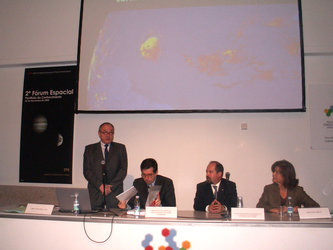First images received at Azore's Santa Maria station
ESA's Envisat has delivered SAR (synthetic aperture radar) images to the ESTRACK ground station at Santa Maria, Azores, Portugal. These are the first such images received and processed at the new station.
The images show oil spills in the Atlantic ocean and can be used for environmental monitoring, demonstrating the value of the 5.5m station's newly developed X-Band receive capability. The station will begin regular receipt and initial processing of Envisat images as of 1 November 2008, as a service provided by industrial partner EDISOFT SA in response to a request by the Portuguese authorities.

The addition of X-Band receipt capability now enables the station to receive data and telemetry from a number of ongoing Earth observation satellites, including ESA's ERS-2 and Envisat, and Canada's Radarsat, among others. The X-Band receipt equipment is owned and operated by EDISOFT.
"With the first images received from Envisat by the Santa Maria station and processed for oil spill detection by EdiSoft, an important step has been made in the exploitation of this new site for the benefit of European citizens and for the long-term use beyond ESA's own requirements of this unique installation," said Manfred Lugert, Head of the Ground Facilities Operations Division with ESA's Operations directorate.
The station was established on the Monte das Flores site in Santa Maria within the frame of an agreement between ESA and the Portuguese authorities and is operated locally under contract by a consortium comprising industrial partners EDISOFT/SEGMA/GlobalEDA of Portugal/Azores.

In addition, Santa Maria station is one of the first ESTRACK stations with launcher-tracking capability and is used to receive real-time telemetry from launches originating from ESA's spaceport in Kourou, French Guiana.
It is capable of tracking Ariane 5, and was used to track the launch of ESA's first Automated Transfer vehicle (ATV), Jules Verne, in March 2008.






